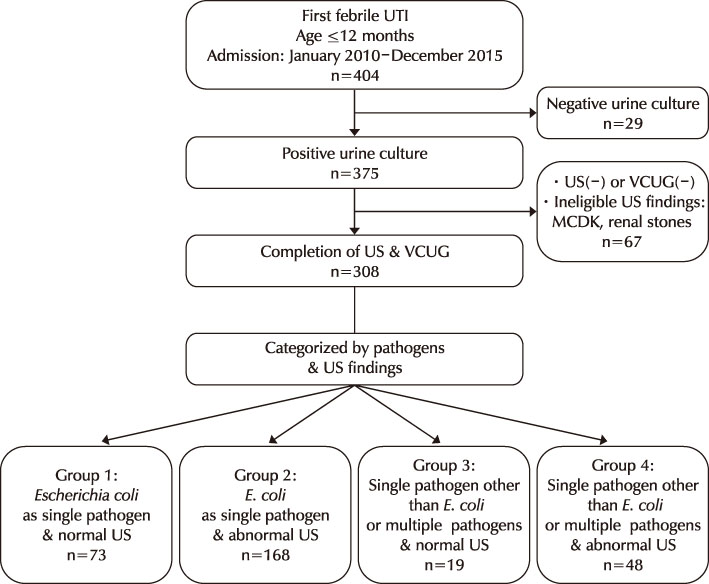Urogenit Tract Infect.
2018 Dec;13(3):58-65. 10.14777/uti.2018.13.3.58.
Analysis of Uropathogens of Febrile Urinary Tract Infection in Infant and Relationship with Vesicoureteral Reflux
- Affiliations
-
- 1Department of Urology, Pusan National University School of Medicine, Yangsan, Korea. busanuro@hanmail.net
- 2Department of Urology, Pusan National University Hospital, Busan, Korea.
- 3Department of Urology, Pusan National University Yangsan Hospital, Yangsan, Korea.
- 4Department of Nursing, Pusan National University Graduate School, Yangsan, Korea.
- KMID: 2431249
- DOI: http://doi.org/10.14777/uti.2018.13.3.58
Abstract
- PURPOSE
This study aimed to investigate the relationship between uropathogens of infants with febrile urinary tract infection (UTI) and vesicoureteral reflux (VUR).
MATERIALS AND METHODS
We analyzed 308 infants hospitalized for febrile UTI between January 2010 and December 2015, and assessed the voiding cystourethrography (VCUG). The medical records, including clinical symptoms, laboratory findings, urinalysis, urine culture tests, ultrasound (US), dimercaptosuccinic acid scan, and VCUG, were retrospectively obtained. The incidences of VUR and high-grade VURs (III, IV, and V) were analyzed in 4 groups categorized by uropathogens and renal US findings.
RESULTS
The mean age of 308 infants was 3.29±2.18 months. The male-to-female ratio was 3.46:1. In urine culture tests, 267 infants (86.69%) showed single bacterial uropathogen; Escherichia coli in 241 infants (78.25%) and non-E. coli uropathogens in 26 infants (8.44%). Multiple distinctive microorganisms were identified as causative uropathogens in 41 infants (13.31%). Abnormal findings of US and VCUG were identified in 216 and 64 patients, respectively. In 308 infants, the incidences of VUR and high-grade VUR were not different among the 4 groups. In 239 male infants, the incidences of high-grade VUR were higher in patients with non-E. coli single or multiple uropathogen and with abnormal US findings (p=0.042).
CONCLUSIONS
In male infants with non-E. coli uropathogen or multiple uropathogens and with abnormal US findings at febrile UTI, there was an increased chance of finding high-grade VURs on subsequent VCUG tests.
MeSH Terms
Figure
Reference
-
1. Shaikh N, Morone NE, Bost JE, Farrell MH. Prevalence of urinary tract infection in childhood: a meta-analysis. Pediatr Infect Dis J. 2008; 27:302–308.2. Greenfield SP, Wan J. Vesicoureteral reflux: practical aspects of evaluation and management. Pediatr Nephrol. 1996; 10:789–794.
Article3. Baker R, Maxted W, Maylath J, Shuman I. Relation of age, sex and infection to reflux: data indicating high spontaneous cure rate in pediatric patients. J Urol. 1966; 95:27–32.
Article4. Duckett JW. Vesicoureteral reflux: a ‘conservative’ analysis. Am J Kidney Dis. 1983; 3:139–144.
Article5. Weiss R, Tamminen-Mobius T, Koskimies O, Olbing H, Smellie JM, Hirche H, et al. The International Reflux Study In Children. Characteristics at entry of children with severe primary vesicoureteral reflux recruited for a multicenter, international therapeutic trial comparing medical and surgical management. J Urol. 1992; 148:1644–1649.
Article6. Skoog SJ, Belman AB, Majd M. A nonsurgical approach to the management of primary vesicoureteral reflux. J Urol. 1987; 138:941–946.
Article7. O'Donnell B, Puri P. Endoscopic correction of primary vesicoureteric reflux. Br J Urol. 1986; 58:601–604.8. Kirsch AJ, Perez-Brayfield M, Smith EA, Scherz HC. The modified sting procedure to correct vesicoureteral reflux: improved results with submucosal implantation within the intramural ureter. J Urol. 2004; 171:2413–2416.
Article9. Subcommittee On Urinary Tract Infection. Reaffirmation of AAP clinical practice guideline: the diagnosis and management of the initial urinary tract infection in febrile infants and young children 2–24 months of age. Pediatrics. 2016; 138:e20163026.10. Mori R, Lakhanpaul M, Verrier-Jones K. Diagnosis and management of urinary tract infection in children: summary of NICE guidance. BMJ. 2007; 335:395–397.
Article11. Ammenti A, Cataldi L, Chimenz R, Fanos V, La Manna A, Marra G, et al. Febrile urinary tract infections in young children: recommendations for the diagnosis, treatment and follow-up. Acta Paediatr. 2012; 101:451–457.
Article12. Farhat W, McLorie G, Geary D, Capolicchio G, Bagli D, Merguerian P, et al. The natural history of neonatal vesicoureteral reflux associated with antenatal hydronephrosis. J Urol. 2000; 164:1057–1060.
Article13. Massanyi EZ, Preece J, Gupta A, Lin SM, Wang MH. Utility of screening ultrasound after first febrile UTI among patients with clinically significant vesicoureteral reflux. Urology. 2013; 82:905–909.
Article14. Wongbencharat K, Tongpenyai Y, Na-Rungsri K. Renal ultrasound and DMSA screening for high-grade vesicoureteral reflux. Pediatr Int. 2016; 58:214–218.
Article15. Ristola MT, Loyttyniemi E, Hurme T. Factors associated with abnormal imaging and infection recurrence after a first febrile urinary tract infection in children. Eur J Pediatr Surg. 2017; 27:142–149.
Article16. Friedman S, Reif S, Assia A, Mishaal R, Levy I. Clinical and laboratory characteristics of non-E. coli urinary tract infections. Arch Dis Child. 2006; 91:845–846.
Article17. Choi EJ, Lee MJ, Park SA, Lee OK. Predictors of high-grade vesicoureteral reflux in children with febrile urinary tract infections. Child Kidney Dis. 2017; 21:136–141.
Article18. Pauchard JY, Chehade H, Kies CZ, Girardin E, Cachat F, Gehri M. Avoidance of voiding cystourethrography in infants younger than 3 months with Escherichia coli urinary tract infection and normal renal ultrasound. Arch Dis Child. 2017; 102:804–808.
Article19. Hayashi Y, Kohri K. Circumcision related to urinary tract infections, sexually transmitted infections, human immunodeficiency virus infections, and penile and cervical cancer. Int J Urol. 2013; 20:769–775.
Article20. Herndon CD, McKenna PH, Kolon TF, Gonzales ET, Barker LA, Docimo SG. A multicenter outcomes analysis of patients with neonatal reflux presenting with prenatal hydronephrosis. J Urol. 1999; 162:1203–1208.
Article
- Full Text Links
- Actions
-
Cited
- CITED
-
- Close
- Share
- Similar articles
-
- Reflux Nephropathy in Children
- Follow up study of urinary tract infection associated with vesicoureteral reflux
- Transient Pseudohypoaldosteronism in an Infant with Vesicoureteral Reflux
- The Relationship between Thymic Size and Vesicoureteral Reflux in Infants with Febrile Urinary Tract Infection
- Clinical Significance and Incidence of Gram-positive Uropathogens in Pediatric Patients Younger than 1 Year of Age with Febrile Urinary Tract Infection


